This tutorial outlines the procedure to perform a linear transient heat transfer analysis on a steel extended-surface heat transfer fin attached to the outer surface of a system generating heat flux (Example: IC engine). The extended surface heat transfer fin analyzed in this tutorial is one of many from an array of such fins connected to the system. The fins draw heat away from the outer surface of the system and dissipate it to the surrounding air. The process of heat transfer out of the fin depends upon the flow of air around the fin (Free or forced convection). In the current tutorial, the focus is on transient heat transfer through heat flux loading and free convection dissipation.
An extended surface heat transfer fin made of steel is illustrated in Figure 1. To meet certain structural design requirements, the fin is bent at 90° at approximately a quarter of its length.
| Tip: | A free convection analysis is conducted in this tutorial; however, if forced fluid flow (forced convection) is allowed over the outer surface of the system, then offsetting the fins from each other periodically, interrupts the growth of a thermal boundary layer and a reduction in flow velocity occurs due to form drag, resulting in a higher heat transfer rate. |
|
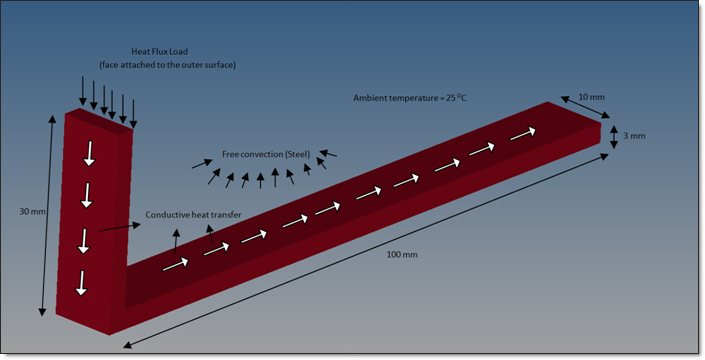
Figure 1: Extended surface heat transfer fin for convective and conductive transient heat transfer.
The extended surface heat transfer fin shown in Figure 1 is meshed with CHEXA elements in HyperMesh and a transient heat transfer analysis is performed in HyperMesh using the Altair OptiStruct solver. A typical heat flux load of 100 KW/m2 is applied to the face connected to the outer surface of the system. An ambient temperature of 25°C is assumed and all material properties are assumed to remain constant with temperature and time. Free (Natural) convection is assumed over the entire surface of the material, wherein heat transfer between the surface of the fin and the surrounding air occurs due to a complex mechanism of density differences as a result of temperature gradients.
| Tip: | In its simplest form, natural convection can be explained as the transfer of heat from the hot surface to a layer of cold air just above it, leading to an increase of temperature within that layer causing a drop in air density. The hot air (less dense) then rises vacating space for a layer of cold air (more dense) that takes its place and so on in a continuous pattern until (if) steady-state is reached. In reality, however, the process of natural convection is highly complex due to the complexities in fluid flow and extensive experimental correlation is required for accurate analysis. |
|
Tutorial Prerequisites
| 1. | The latest version of Altair HyperMesh, Altair HyperView and Altair OptiStruct software installations. Transient heat transfer analysis is available only in Altair HyperMesh version-12.0.110, Altair HyperView version-12.0.110 and Altair OptiStruct version-12.0.202 and later. |
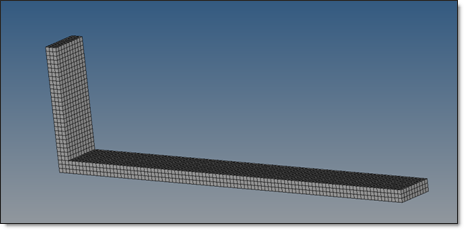
Figure 2: Heat exchanger fin model for Transient Heat Transfer Analysis.
Brief Introduction to Linear Transient Heat Transfer Analysis
Linear transient heat transfer analysis can be used to calculate the temperature distribution in a system with respect to time. The applied thermal loads can either be time-dependent or time-invariant; transient thermal analysis is used to capture the thermal behavior of a system over a specific period in time.
The basic finite element equation for transient heat transfer analysis is given by:
 | (1) |
Where,
[C] is the heat capacity matrix
[K] is the conductivity matrix
[H] is the boundary convection matrix due to free convection
 is the temperature derivative with respect to time
is the temperature derivative with respect to time
{T} is the unknown nodal temperature
{p} is the thermal loading vector.
The differential equation (1) is solved to find nodal temperature {T} at the specified time steps. The difference between equation (1) and the steady-state heat transfer equation is the term,  that captures the transient nature of the analysis.
that captures the transient nature of the analysis.
Checkpoint
Steady-state heat transfer analysis, generally, is sufficient for a wide variety of applications. However, in situations where the system properties vary significantly over time the transient nature of heat transfer must be considered. Some examples are the relatively slow heating up of airplane gas turbine compressor disks compared to the turbine casing leading to aerodynamic issues during takeoff or the analysis of the time taken for the onset of frostbite in fingers or toes.
The following exercises are included:
| • | Creating the thermal material and the solid property for the given component |
| • | Assigning the material and property to the component |
| • | Creating flux and convective loads and boundary conditions for the model |
| • | Submitting the job to Altair OptiStruct |
| • | Post-processing the results using Altair HyperView |
Setting up the Model in HyperMesh
Step 1: Loading the OptiStruct User Profile and importing the model into HyperMesh
| 2. | Select OptiStruct in the User Profiles dialog. |
| 3. | Click OK. This loads the OptiStruct user profile. It includes the appropriate template, macro menu, and import reader, paring down the functionality of HyperMesh to what is relevant for generating models for OptiStruct. |
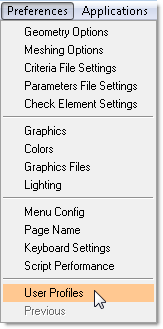
Figure 3: Alternate method for accessing the "User Profiles" option from the Preferences menu.
| 4. | Click the Import Solver Deck icon  . An Import panel opens. . An Import panel opens. |
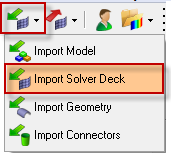
Figure 4: Importing the solver deck into HyperMesh.
| 5. | Set the File type: to OptiStruct. |
| 6. | Click the open file icon  in the File: field. A Select OptiStruct file browser window opens. in the File: field. A Select OptiStruct file browser window opens. |
| 7. | Select the heat_transfer_fin.fem file you saved to your working directory from the optistruct.zip file. Refer to Accessing the Model Files. |
| 8. | Click Open. The location of heat_transfer_fin.fem displays in the File: field. |
| 9. | Click Import. The heat_transfer_fin.fem database is loaded into the current HyperMesh session. |
Step 2: Creating the thermal material and property
The imported model only contains the component and predefined element sets for boundary condition creation. Now create a thermal material that can be assigned to this component.
| 1. | In the Model browser, right-click and select Create > Material. A default MAT1 material displays in the Entity Editor. |
| 3. | For Card Image, select MAT4 and click Yes to confirm. |
| 4. | Enter the following material property values for the MAT4 data entry. |
[K] Thermal Conductivity = 7.3 x 10-2 W/mm °C.
[CP] Heat Capacity at constant pressure = 508 J/Kg °C
[RHO] Density of the material = 7.9 x 10-6 Kg/mm3
[H] Coefficient of heat transfer = 4 x 10-5 W/mm2 °C
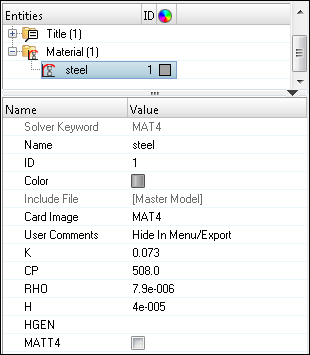
Since you are conducting a purely heat transfer analysis, structural isotropic properties (for example, MAT1 card) are not required. Also, it is assumed that the thermal material properties (MAT4) are temperature independent.
A new material, steel, is created with thermal properties necessary for a transient heat transfer analysis.
Now, create the solid property for this model referencing the PSOLID entry and connect the material, steel, to this property; the property can then be assigned to the existing component.
| 5. | In the Model browser, right-click and select Create > Property. A default PSHELL property displays in the Entity Editor. |
| 7. | For Card Image, select PSOLID and click Yes to confirm. |
| 8. | For Material, click Unspecified > Material. |
| 9. | In the Select Material dialog, select steel and click OK. |
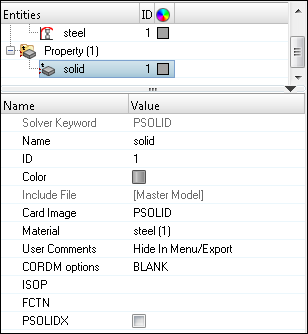
Step 3: Linking the material and property to the existing structure
Once the material and property are defined, they need to be linked to the structure.
| 1. | In the Model browser, click the component auto1. The Entity Editor opens. |
| 2. | For Property, click Unspecified > Property. |
| 3. | In the Select Property dialog, select solid and click click OK. |
The material steel now is automatically linked to the component auto1.
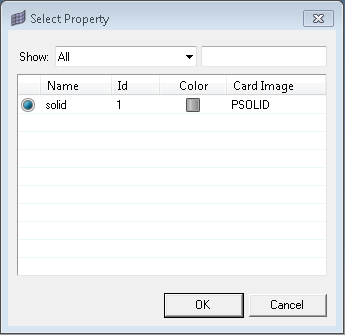
Step 4: Creating time-steps for the transient heat transfer analysis
A transient analysis captures the behavior of the system over a specific period of time. Therefore, a time period of interest for your system is defined. A time period of 500 seconds (8 minutes, 20 seconds) is defined with results output every 10 seconds. A load collector is created for this purpose and the TSTEP entry is referenced, as shown below:
| 1. | In the Model browser, right-click and select Create > Load Collector. |
| 2. | For Name, enter Time Steps. |
| 3. | For Card Image, select TSTEP. |
| 4. | For TSTEP_NUM, enter a value of 1. |
| 5. | Click  and enter the number of time steps (N) = 50 and set each time increment (DT) to 10. and enter the number of time steps (N) = 50 and set each time increment (DT) to 10. |
This encompasses a total time period of 500 seconds in which to capture the behavior of the system.
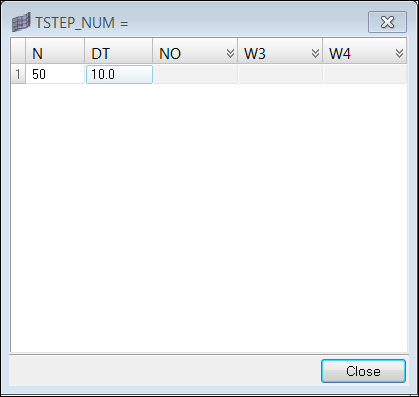
Step 5: Creating initial conditions for the transient heat transfer analysis
Since the temperature profile of the system varies over time, the initial grid point temperature profile must be set to specify the starting point for the analysis. You assume that the temperature of the entire system is equal to 25°C at T=0 seconds, the TEMPD bulk data entry sets the initial temperatures.
| 1. | In the Model browser, right-click and select Create > Load Collector. |
| 2. | For Name, enter Initial Conditions. |
| 3. | For Card Image, select TEMPD. |
| 4. | For T1, enter a value of 25. |
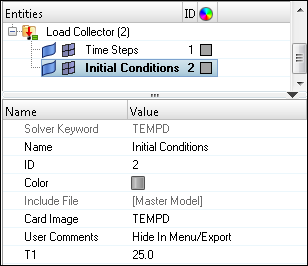
Applying Ambient Temperature Boundary Conditions on the Model
Ambient temperature thermal boundary conditions is applied on the model by creating specific load collectors for each. The ambient temperature is controlled using an SPCD entry, as this will allow an ambient temperature variation over time to help mimic such physical requirements (if any).
Step 6: Creating a time-variant ambient temperature
A time variable ambient temperature can be created by referencing an SPCD entry via a TLOAD1 data entry. The time variable nature of the ambient temperature can be captured using a TABLED1 entry also referenced by the TLOAD1 data.
| 1. | In the Model browser, right-click and select Create > Load Collector. |
| 2. | For Name, enter Ambient SPCD TLOAD1. |
| 3. | For Card Image, select TLOAD1. The TLOAD1 fields will be updated after the creation of the corresponding SPCD and TABLED1 data entries. |
| 4. | Create another load collector named Ambient SPCD, and for Card Image, select None. The newly created Ambient SPCD load collector is the current load collector (look at the right bottom corner of the screen to verify that Ambient SPCD is displayed). |
| 5. | If the Ambient SPCD load collector is not specified, right-click Ambient SPCD in the Model browser and click Make Current. |

Figure 5: Displaying the current load collector - Ambient SPCD
| 6. | Next, create the amplitude (constant part) of the time variant ambient temperature using an SPCD data entry. Click BCs > Create > Constraints. |
| 7. | The ambient temperature is set by using the SPCD data entry to control an existing node outside the actual structure. In the Constraints panel, click nodes > by id, enter 5672 in the id= field and press Enter. The ambient node is highlighted in the graphics window above the structure. |
| 8. | Enter 5.0 in the size= field and uncheck the boxes beside all the degrees of freedom (dof1 through dof6) and enter 0.0 in all the fields next to the dof#. |
| 9. | For load types =, select SPCD. |

Figure 6: Creating an SPCD entry to control the ambient temperature.
| 10. | Click create/edit and enter 25.0 in the D field on the SPCD data entry. This creates an SPCD referencing the ambient node specifying a temperature of 25°C. |
| 11. | Click return twice to go back to the Analysis page. |
| 12. | Next, create another load collector to define the time variant nature of the ambient temperature. This is done by specifying a TABLED1 entry referenced by the previously created TLOAD1 entry. |
| 13. | Create a new load collector (refer to Step 6.1) named Ambient SPCD Table, and set Card Image, as TABLED1. |
| 14. | For TABLED1_NUM, enter 2 and press ENTER. |
| 15. | In the table, enter x(1) = 0.0, y(1) = 1.0, x(2) = 500.0, and y(2) = 1.0. |
| Tip: | In this tutorial, a constant ambient temperature (the values of y(1) and y(2) are the same leading to a constant temperature distribution over the first 500 seconds) is defined; however, this demonstrates the procedure to use a TABLED1 entry to specify a time variant ambient temperature as well. To do this, specify different values for the y# fields and depending on the type of variation required, select from LINEAR or LOG options. |
|
Checkpoint
The SPCD and its corresponding table are linked to the previously created TLOAD1 entry.
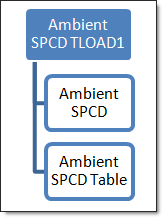
Figure 7: Process to specify a time-variant SPCD
| 17. | In the Model browser, click the Ambient SPCD TLOAD1 load collector. It is displayed in the Entity Editor. |
| 18. | For EXCITEID, select the Ambient SPCD load collector from the menu. |
| 19. | For TYPE, select DISP, then click TID and select the Ambient SPCD Table load collector menu. |
All entities referenced by SPCD entries should also be constrained by SPC data entries. The value of the corresponding SPC referencing an ambient point controlled via an SPCD by TLOAD1/2 entries should be equal to zero (0.0).
| 20. | Create a new load collector (refer to Step 6.1) named Ambient SPC and for Card Image, select None. |
| 21. | Make sure that the newly created load collector Ambient SPC is current and click BCs > Create > Constraints and click nodes in the Constraints panel. Select by id from the extended menu, enter 5672 and press Enter. The ambient node is highlighted in the graphics window above the structure. |
| 22. | Enter 5.0 in the size= field and uncheck the boxes beside all the degrees of freedom (dof1 through dof6) and enter 0.0 in all the fields next to the dof#. |
| 23. | For load types =, select SPC. |

Figure 8: Creating the SPC boundary condition.
| 24. | Click create/edit and enter 0.0 in the D field on the SPC data entry. This creates an SPC referencing the same ambient node that is controlled by the SPCD data entry. |
| 25. | Click return twice to go back to the Analysis page. |
Applying a Heat Flux Load to the Model
Ambient temperature thermal boundary conditions have been assigned to the model and heat flux load from the outer surface of the engine (to which the fin is attached) is applied on the model. A time-varying heat flux load of 0 to 0.1 W/mm2 from 0 to 500 seconds is used for the analysis of this fin. This load is applied on the model by creating specific load collectors for the corresponding TLOAD1, QBDY1 and TABLED1 entries similar to the procedure used for the ambient temperature SPCD definition.
Step 7: Creating a time-variant linearly increasing heat flux load
A time variable ambient temperature can be created by referencing an SPCD entry via a TLOAD1 data entry. The time variable nature of the ambient temperature can be captured using a TABLED1 entry also referenced by the TLOAD1 data.
| 1. | Create a new load collector (refer to Step 6.1) named Heat Flux TLOAD1 and select TLOAD1 as the Card Image. The TLOAD1 fields will be updated after the creation of the corresponding QBDY1 and TABLED1 data entries. |
| 2. | Create another load collector (refer to Step 6.1) named Heat Flux QBDY1 and select None as the Card Image. The newly created Heat Flux QBDY1 load collector is the “current” load collector (look at the right bottom corner of the screen to verify if Heat Flux QBDY1 is displayed). |
| 3. | If the Heat Flux QBDY1 load collector is not specified, right-click Heat Flux QBDY1 in the Model browser and click Make Current. |

Figure 9: Displaying the current load collector - Heat Flux QBDY1.
| 4. | An interface is now created between the heat flux source and the solid elements on the surface of the fin. This is done by clicking BCs > Create > Interfaces and specifying conduction_interface in the Name field of the Create group dialog. |
| 5. | For Card Image, select CONDUCTION from the drop-down menu and click Yes to confirm. |
| 6. | For Slave Entity IDs, click on the yellow Elements panel. A panel appears under the graphics area. |
| 7. | Click on the switch button beside elems and select faces from the list. |
| 8. | Click the highlighted solid elems and select by sets from the selection menu. |
| 9. | Check the box next to Element_set_Flux and click select. The predefined element set is now highlighted in white on the model. |
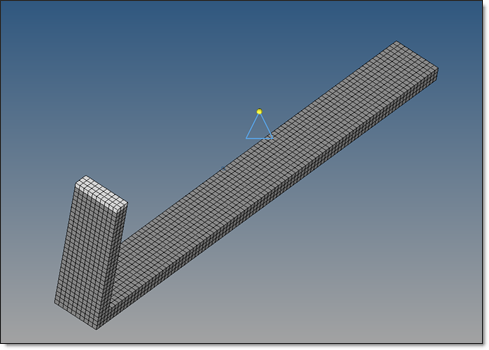
Figure 10: Highlighted element set is displayed in white.
| Tip: | The break angle helps find adjacent solid faces for the same element set, however, since this surface element set generation requires only one face, the value of the break angle is not germane in this situation. |
|
| 10. | Click nodes and select the nodes in the Figure 11. |
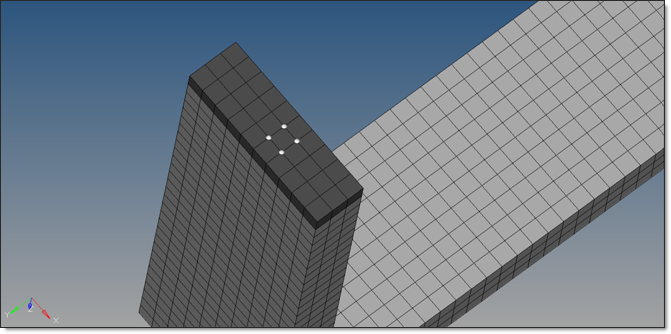
Figure 11: Selecting the nodes on the highlighted surface for conduction surface element creation.
| 11. | Click add and return to go back to the Create group dialog. |
| 13. | A conduction interface is created because QBDY1 data can only reference surface elements and the conduction interface helps us create a set of surface elements at the surface where heat flux is input. |
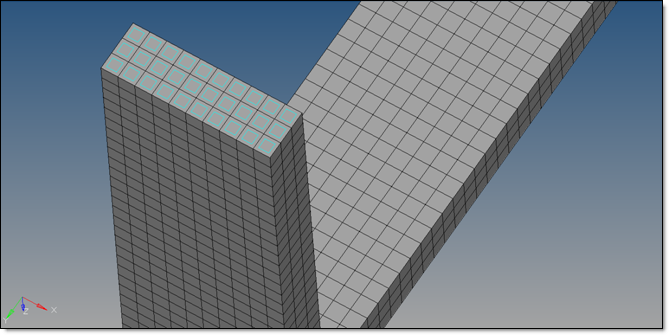
Figure 12: Newly generated surface elements are displayed in blue as shown above.
| 14. | Next, create the amplitude (constant part) of the time variant heat flux using a QBDY1 data entry. Do this by clicking on BCs > Create > Flux. |
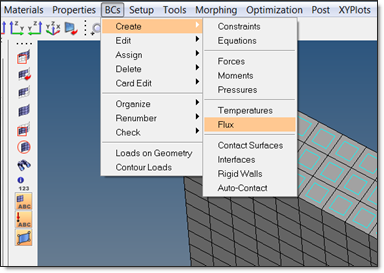
Figure 13: Accessing these Flux creation panel.
| 15. | Click elems, select by group and select conduction_interface. The newly created surface elements are highlighted in white on the model. |
| 16. | Enter 0.1 in the value= field and select QBDY1 in the load types = field. Specify any low value in the magnitude% = field to assign a value to the size of the display label for the flux load. |

Figure 14: Heat flux load panel.
| 17. | Click create and return to go back to the Analysis page. |
| 18. | Next, create another load collector to define the linear time variant nature of the heat flux. This is done by specifying a TABLED1 entry referenced by the previously created TLOAD1 entry. |
| 19. | Create a new load collector (refer to Step 6.1) named Heat Flux Table and select TABLED1 as the Card Image. |
| 20. | For TABLED1_NUM, enter 2 and press ENTER. |
| 21. | Click  next to Data. In the pop-out window, enter x(1) = 0.0, y(1) = 0.0, x(2) = 500.0 and y(2) = 1.0. next to Data. In the pop-out window, enter x(1) = 0.0, y(1) = 0.0, x(2) = 500.0 and y(2) = 1.0. |
| Tip: | In this tutorial, a linearly incremental heat flux load (the values of y(1) and y(2) are 0 and 1 leading to a linearly increasing heat flux distribution over the first 500 seconds) is defined. |
|
Checkpoint
The QBDY1 flux load and its corresponding table are linked to the previously created TLOAD1 entry.
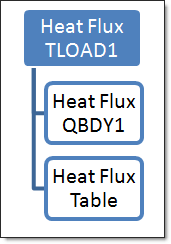
Figure 15: Process to specify a time-variant SPCD
| 22. | In the Model browser, click the Heat Flux TLOAD1 load collector. The entry is displayed in the Entity Editor below. |
| 23. | For Card Image, select TLOAD1. |
| 24. | For EXCITEID, select the Heat Flux QBDY1 load collector from the pop-out table and click OK. |
| 25. | For TYPE, select LOAD, then click TID and select the Heat Flux Table from the pop-out table and click OK. |
Adding Free Convection to the Model
Free convection is assigned in a similar manner to the procedure used for the creation of the conduction interface. Free convection is, however, automatically assigned to all heat transfer subcases and the PCONV and CONV entries should refer to the material, steel, and the ambient temperature. The ambient temperature calculates the amount of heat transferred through free convection.
Step 8: Creating surface elements for free convection
Surface elements are to be created to simulate the heat exchange between the fin surface and the surrounding air. A predefined element set Element_set_convection, which contains the solid elements on the outer surface of the fin defines the surface elements at the interface.
| 1. | An interface is now created between the surrounding air and the solid elements on the surface of the fin. This is done by clicking BCs > Create > Interfaces and specifying convection_interface in the Name field of the Create group pop-up table. |
| 2. | For Card Image, select CONVECTION from the drop-down menu and click Yes to confirm. |
| 3. | For Slave Entity IDs, click on the yellow Elements panel. A panel appears under the graphics area. |
| 4. | Click on the switch button beside elems and select faces from the list. |
| 5. | Click the highlighted solid elems and select by sets from the selection menu. |
| 6. | Select element set Element_set_Convection and click select. The predefined element set is now highlighted in white on the model. |
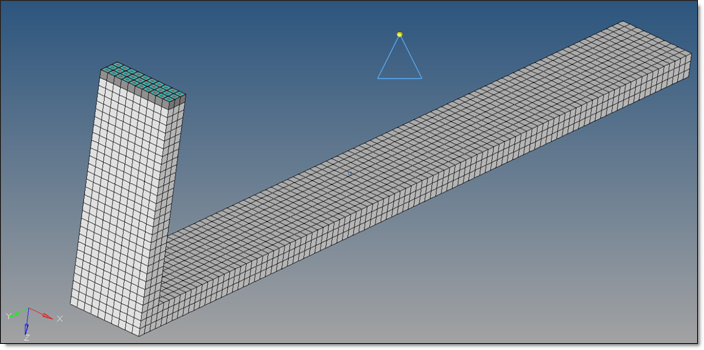
Figure 16: The highlighted element set is displayed in white.
| 7. | Click nodes next to face nodes:, this highlights the same element set in black. Click any four nodes on all highlighted faces of the model as shown in Figures 17 and 18 and specify a break angle of 89°. |
| Tip: | The break angle helps find adjacent solid faces for the same element set, all adjacent faces with the angle between surface normals less than the specified break angle are selected for surface element creation. |
|
| 8. | Click add and return to go back to the Analysis page. |
| 9. | Click the MID field and select steel from the menu. |
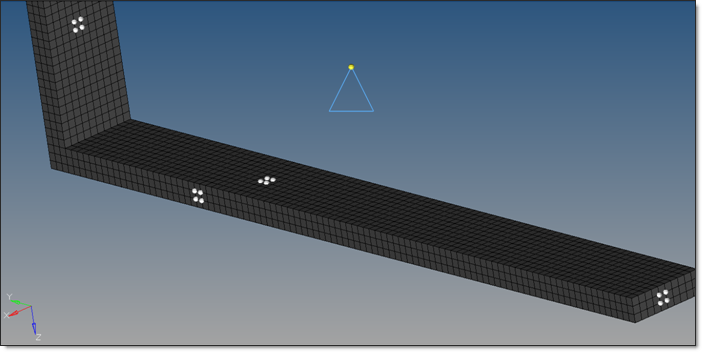
Figure 17: Selecting the nodes on four of the seven highlighted surfaces for convection surface element creation.
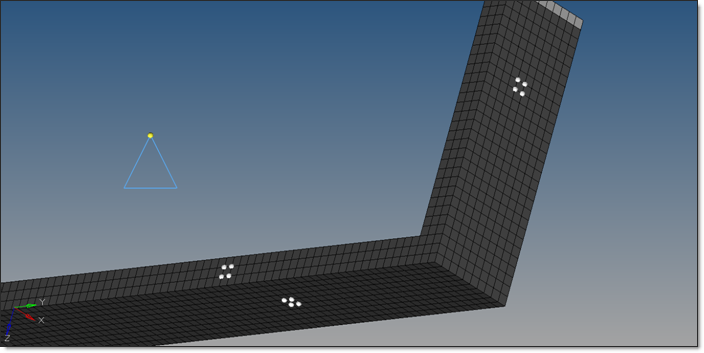
Figure 18: Selecting nodes on the three remaining highlighted surfaces for the creation of a convection interface
The newly created CHBDYE surface elements are displayed in yellow, as shown in Figure 19 below.
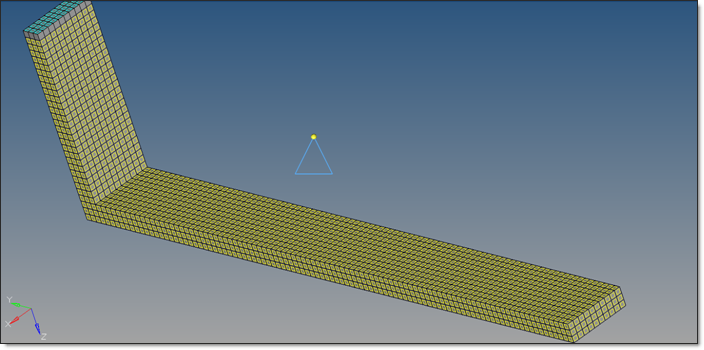
Figure 19: Newly generated CHBBDYE surface elements are displayed in yellow on the model.
A new group convection_interface is created in the Model browser.
| 11. | Next, the convection boundary condition is defined by referencing the ambient temperature in the CONV data entry. This is done by clicking on the Card Edit icon  and selecting the elems entry. and selecting the elems entry. |
| 12. | Click elems > by group and select convection_interface from the menu. |
| 13. | Click config= and select slave4. |
| 14. | Click type= and select CHBDYE4. |
| 15. | Click edit and go to the CHBDYE card image panel. |
| 16. | Check the box beside CONV. Click TA1 and input the ambient node ID 5672. |
| 17. | Click return twice to go back to the Analysis page. |
Step 9: Combining the two TLOAD1 entries into one DLOAD entry.
Two different TLOAD1 entries have been defined and since they are to be referenced in the same subcase they should be combined using a DLOAD data entry.
| 1. | Create a new load collector (refer to Step 6.1) named Combined Flux and Convection and select DLOAD as the Card Image. |
| 3. | As only a simple linear addition of the two TLOAD1 entries are required, for DLOAD_NUM, enter 2 and press Enter. |
| 4. | Click  next to Data below the DLOAD_NUM field. In the DLOAD_NUM pop-up window, enter S(1) = 1.0 and S(2) = 1.0. next to Data below the DLOAD_NUM field. In the DLOAD_NUM pop-up window, enter S(1) = 1.0 and S(2) = 1.0. |
| 5. | For L(1), select Ambient SPCD TLOAD1 from the menu and for L(2), select Heat Flux TLOAD1 from the menu. |
Checkpoint
The DLOAD entry is created as a linear combination of two TLOAD1 entries – Heat Flux TLOAD1 and Ambient SPCD TLOAD1.
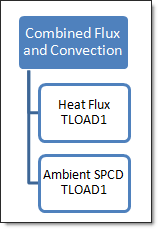
Figure 20: Process to specify a time-variant SPCD
Step 10: Creating a transient heat transfer loadstep
An OptiStruct transient heat transfer loadstep is created which references the time steps in the load collector Time Steps, the initial conditions in the load collector Initial Conditions, the heat flux and free convection setup in the load collector Combined Flux and Convection, and the SPC boundary condition in the load collector Ambient SPC. The gradient, flux, and temperature output for the heat transfer analysis is also requested in the loadsteps panel.
| 1. | In the Model browser, right-click and select Create > Load Step. |
| 2. | For Name, enter transient heat transfer. |
| 3. | Click the Analysis type field and select Heat transfer (transient) from the drop-down menu. |
| 4. | For SPC, click Unspecified > Loadcol. |
| 5. | In the Select Loadcol dialog, select Ambient SPC from the list of load collectors and click OK to complete the SPC selection. |
| 6. | For IC, select Initial Conditions. |
| 7. | For TSTEP, select Time Steps. |
| 8. | For DLOAD, select Combined Flux and Convection. |
| 9. | Check the box next to Output. |
| 10. | Activate the options of FLUX and THERMAL on the sub-list. |
| 11. | Activate the FORMAT fields for both outputs and select H3D format. |
| 12. | Activate the OPTION fields for both outputs and select ALL. The FORMAT and OUTPUT fields for THERMAL output may open up a new window. Click on the first field in the window to select the corresponding values. |
FLUX and THERMAL output can also be requested in control cards panel on Analysis page.
Submitting the job to OptiStruct
Step 11: Launch OptiStruct
| 1. | From the Analysis page, select the OptiStruct panel. |
| 2. | Click save as following the input file: field. A Save As browser window opens. |
| 3. | Select the directory where you would like to write the OptiStruct model file and enter the name for the model, heat_transfer_fin_complete.fem, in the File name: field. The .fem filename extension is the recommended extension for OptiStruct input decks. |
The name and location of the heat_transfer_fin_complete.fem file displays in the input file: field.
| 5. | Set the memory options: toggle to memory default. |
| 6. | Click the run options: switch and select analysis. |
| 7. | Set the export options: toggle to all. |
| 8. | Click OptiStruct. This launches the job. |
If the job is successful, you should see new results files in the directory from which heat_transfer_fin_complete.fem was selected. The heat_transfer_fin_complete.out file is a good place to look for error messages that could help debug the input deck if any errors are present.
Viewing and Post-processing the Results
Grid temperatures, element temperature gradients and flux contour results are computed for the transient heat transfer analysis and HyperView are used to post-process the results.
Step 12: Viewing the results of the transient heat transfer analysis
| 1. | When the message Process completed successfully is received in the command window, click HyperView. HyperView is launched and the results are loaded. |
A message window appears to inform of the successful model and result files loading into HyperView.
| 2. | Click Close to close the message window, if one appears. |
| 3. | Click the Contour toolbar icon  . . |
| 4. | Select the first pull-down menu below Result type: and select Grid Temperatures(s). |

Figure 21: Contour plot panel in HyperView.
| 5. | Click Apply, select Time = 5.0000000E+02 from the Results browser. A contour plot of grid temperatures at the final time step is created as shown in Figure 22. |
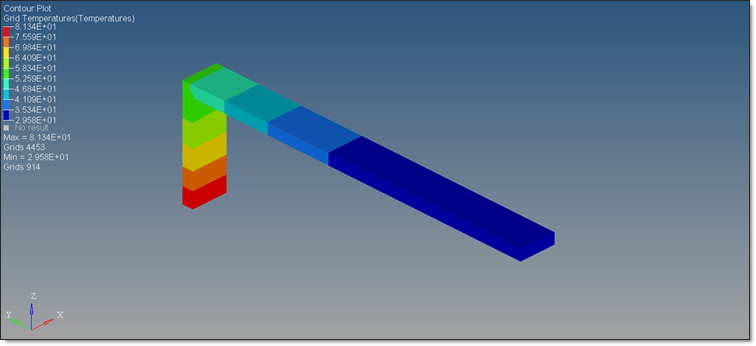
Figure 22: Grid temperature contour for the final time step (500 seconds) – WITH FREE CONVECTION.
Checkpoint
In Figure 22, this is the grid point temperature plot after 500 seconds. The system is input a linearly increasing heat flux from 0 to 0.1 W/mm2 from 0 to 500 seconds respectively. Therefore, a physical correlation can be the effect of starting an IC engine to full capacity wherein the flux transmitted to the outer surface linearly increases with time. Note that the flux patterns in actuality may be different and may fluctuate based on the duration of the power cycles. The maximum temperature of 81.3°C predictably occurs at the elements closest to the heat flux loading site and the minimum temperature of 29.5°C occurs at elements farthest from the heat source.
| 6. | Click Apply, select Time = 2.0000000E+01 from the Results browser. A contour plot of grid temperatures is created, as shown in Figure 23. |
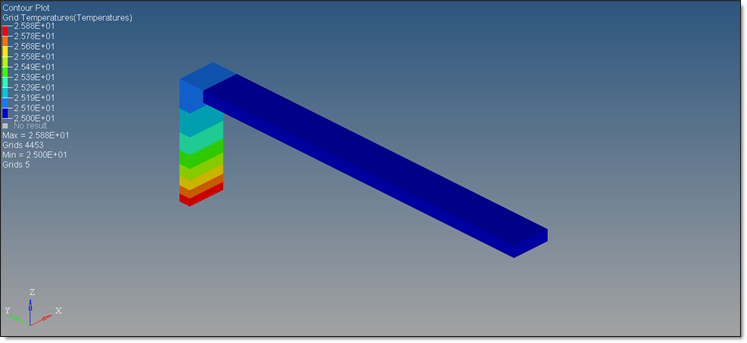
Figure 23: Grid temperature contour plot after 20 seconds – WITH FREE CONVECTION.
| 7. | Select the first pull-down menu below Result type: and select Element Fluxes (V). |
| 8. | Click Apply, select Time = 5.0000000E+02 from the Results browser to view the element flux results after 500 seconds in Figure 25. |
Checkpoint
In a practical setting, you can also see the effect of free convection in the reduction of temperature at the outer surface of the system. Convection (due to the extended surface area) allows a larger amount of heat to be drawn out of the system when compared to the absence of an extended surface fin. This is evident in the temperature of the outer surface of the system after 500 seconds in the absence of convection heat loss.
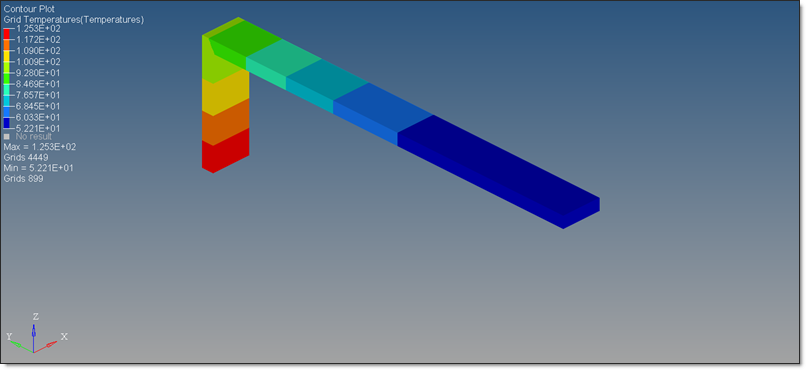
Figure 24: Grid Temperature Contour Plot after 500 seconds - WITHOUT FREE CONVECTION
The maximum temperature at the outer surface of the heat source system is 125.3°C which is an increase of 44°C in 500 seconds. Therefore using an extended surface fin is a very effective way to reduce the temperature of a system.
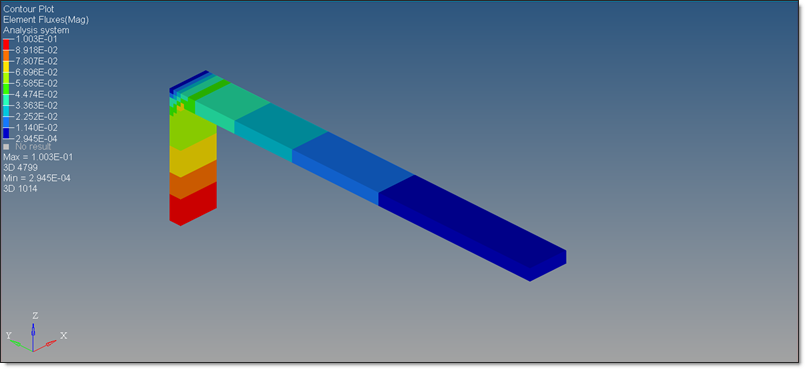
Figure 25: Contour plot of Element fluxes after 500 seconds.
See Also:
OptiStruct Tutorials






































